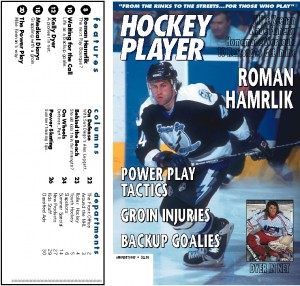Shots That Score


This first appeared in the 08/1995 issue of Hockey Player Magazine®
Shots that score
By Wayne Anderson
Watching a roller hockey team practice at the local rink, I saw almost every player work on their slap shot while warming up the goaltender. Down at the other end there was one player practicing on an open net, trying from in close to score in the top corners. In the game that followed, guess who scored a couple of goals?
Shots that score
Let’s talk a little about shooting, and the shots that score goals.
The slap shot, with the big wind up and the powerful “slap” of the puck, looks awesome. But, in fact, it’s the least accurate and least deadly shot in your arsenal, and as you participate in higher levels of play you’ll find yourself scoring fewer and fewer goals with the slapper. That’s why I call the slap shot “the goaltender’s best friend.”
Almost always, the best shot to use is the wrist shot. To master this, or any other shot, you must be willing to practice. And to practice the wrist shot effectively you first need to hold your stick properly.
Your top hand should grip the top of the stick either on or just under the butt-end. Your lower hand should be positioned comfortably below the upper hand. The best way to make sure you have the proper hand position is to set your top hand, then take your opposite elbow and place it on your upper hand’s thumb. Rest your forearm along the shaft of the stick, grab the stick and then release your elbow. This should give you good hand placement and a comfortable grip.
Hand Placement Matters
Hand placement is important because if your bottom hand is too low you will be forcing your head to dip. If your lower hand is too high, you will lose power and control. Now rest the stick in your fingers comfortably — don’t squeeze the life out of it.
The wrist shot starts with the puck in the middle of the stick blade. Take the puck back in your stance and transfer your weight to the rear foot. With a sweeping forward motion, while at the same time transferring the weight to the front foot, snap the puck while rolling your lower wrist over and following through. You generate most of your power by using the big muscles of your legs to put your body weight into the shot. The wrist roll is also an important factor in getting all of the momentum of the stick blade into the puck. If you want to shoot high, follow through high. To shoot low, follow through low.
Look at your follow-through. Is the forehand side of the stick blade facing down toward the playing surface? If not, you’re not rolling over your wrists. Keep practicing until your follow through is consistently “over the top.”
Where’s The Hole?
The biggest advantage of the wrist shot is that you can look where the puck is going as you are shooting. It does no good to look at the net, find an open spot, then — as with the slapper — look down to shoot, because the goalie can move to fill the hole. You’ll often end up shooting into the pads or chest of the goalie while a whole other portion of the net opens up. The wrist shot lets you find your hole and shoot at the same time.
Once you master the wrist shot you are ready for the goaltender’s nightmare: the backhand. Most goalies will tell you that the backhand, when shot properly, is their biggest problem because it is very hard to read. They do not know where the puck is going off your stick.
For the shooter, the backhand is a mirror of the wrist shot in which you use the back side of the stick. The only thing you change is the position of the puck on the blade. The puck must start closer to the heel of the blade rather than in the middle.
The most common error on the backhand is not rolling the wrists over at the end. Again, a simple way to see if you shooting properly is to check the blade of the stick after the follow-through. If the backhand side of the stick is facing down toward the surface, you are rolling over your wrists correctly. If the forehand side is facing down, you still need more practice.
But keep working on these two shots. The practice will pay off in goals!
Wayne Anderson is Managing Director of Huron Hockey’s new roller hockey schools.
This first appeared in the 08/1995 issue of Hockey Player Magazine®
© Copyright 1991-2011 Hockey Player® and Hockey Player Magazine®

